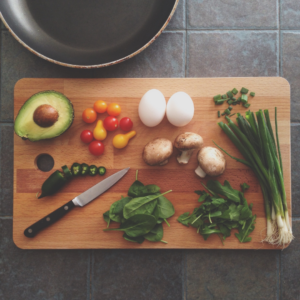Choosing the Right Cutting Board
go.ncsu.edu/readext?1051166
en Español / em Português
El inglés es el idioma de control de esta página. En la medida en que haya algún conflicto entre la traducción al inglés y la traducción, el inglés prevalece.
Al hacer clic en el enlace de traducción se activa un servicio de traducción gratuito para convertir la página al español. Al igual que con cualquier traducción por Internet, la conversión no es sensible al contexto y puede que no traduzca el texto en su significado original. NC State Extension no garantiza la exactitud del texto traducido. Por favor, tenga en cuenta que algunas aplicaciones y/o servicios pueden no funcionar como se espera cuando se traducen.
Português
Inglês é o idioma de controle desta página. Na medida que haja algum conflito entre o texto original em Inglês e a tradução, o Inglês prevalece.
Ao clicar no link de tradução, um serviço gratuito de tradução será ativado para converter a página para o Português. Como em qualquer tradução pela internet, a conversão não é sensivel ao contexto e pode não ocorrer a tradução para o significado orginal. O serviço de Extensão da Carolina do Norte (NC State Extension) não garante a exatidão do texto traduzido. Por favor, observe que algumas funções ou serviços podem não funcionar como esperado após a tradução.
English
English is the controlling language of this page. To the extent there is any conflict between the English text and the translation, English controls.
Clicking on the translation link activates a free translation service to convert the page to Spanish. As with any Internet translation, the conversion is not context-sensitive and may not translate the text to its original meaning. NC State Extension does not guarantee the accuracy of the translated text. Please note that some applications and/or services may not function as expected when translated.
Collapse ▲ People often ask me which is better wood or plastic cutting boards. Now a days, cutting boards come in all types of materials. As far as food safety is concerned, you can choose between wood or nonporous surfaces such as plastic, marble, glass or pyroceramic. You just want to make sure that you are using, cleaning and sanitizing safely. Keep in mind a few things and you really can use which ever type of cutting board you like best.
People often ask me which is better wood or plastic cutting boards. Now a days, cutting boards come in all types of materials. As far as food safety is concerned, you can choose between wood or nonporous surfaces such as plastic, marble, glass or pyroceramic. You just want to make sure that you are using, cleaning and sanitizing safely. Keep in mind a few things and you really can use which ever type of cutting board you like best.
Avoid Cross-Contamination
The first thing to keep in mind is to avoid cross contamination between your foods such as raw meats, poultry and seafood and food that are ready to eat such as fresh vegetables, fruits, breads and cheeses. You can find plastic cutting boards in different colors to help you keep track of which you are using for which type of food. You don’t want to mistakenly use the cutting board you just cut up your raw chicken with the fresh broccoli which you may not cook to as high a temperature to prevent illnesses like salmonella which is associated with raw or undercooked poultry. If using wooden boards, you can mark them if you want to always use the same boards for different foods.
Cleaning and Sanitizing Your Cutting Boards
Deciding which cutting board to use may come down to how you want to clean and sanitize them. To keep cutting boards clean, wash them with hot, soapy water after each use; then rinse with clear water. You can sanitize both wooden and plastic cutting boards with a solution of 1 Tablespoon of unscented, liquid chlorine bleach per gallon of warm or cool water. Flood the surface with the bleach solution and allow it to stand for several minutes. You can also use commercial sprays and follow their directions for how long to keep the solution on the surfaces. Follow up with rinsing with clear water and allow to thoroughly air dry. It is important to let the cutting boards get completely dry before storing them away or stacking them. It can be best to store in a way that prevents trapping moisture between boards.
Many nonporous acrylic, plastic or glass boards can be washed and sanitized in the dishwasher. You still want to make sure that you allow them to thoroughly dry before storing away. Trapped moisture can promote bacteria to grown on the surfaces.
If you have bamboo cutting boards, they are harder and less porous than other wooden cutting boards. They can be nice to use because they absorb very little moisture and resist scarring from knives thus preventing bacteria from growing. To clean bamboo cutting boards, wash with hot soapy water; rinse with clear water and sanitize if desired. After drying rub them with mineral oil to help prevent cracking over time.
Replace Worn Cutting Boards As Needed
Another protective action you can take with cutting boards is to replace cutting boards when they start to show extra wear. The hard to clean grooves that can develop over time can end up being a place that bacteria can grow. If you have some sentimental attachment to the cutting boards, as sometimes we can feel with some of the old wooden boards passed down, plan to use them in other ways than preparing food. You can use them as trivet or hot pad.
Resources: USDA Cutting Boards




